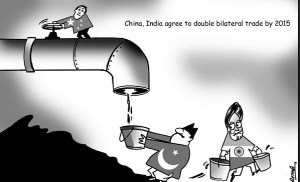A. G. Noorani writes: Chinese President Xi Jinping’s visit to India, from Sept 17 to 19, was successful in some important respects but not so in others. On matters economic, success was predictable and achieved. Politically, the result was disappointing.
Uniquely, the Chinese president’s visit began from Ahmedabad, in the prime minister’s home state Gujarat. The talks, which began there, were continued in Delhi. Both sides agreed that the boundary question should be settled “at an early date”. Neither spelt out by which process.
A boundary agreement defines the border which is then demarcated actually on the ground. Xi’s stand was simple: there’s no need to freeze the existing status quo by demarcating the LAC. That will postpone the agreement on a proper boundary. Instead, both parties should negotiate a settlement “at an early date”.
Thereby hangs a tale. In September 1993 India and China concluded an agreement on “the resolution of differences between the two sides on the alignment of the Line of Actual Control”. Three years later, they signed another agreement “to speed up the process of clarification and confirmation of the Line of Actual Control.” As an “initial step”, the segments on which their perceptions differed would be taken up. Maps would be exchanged “indicating their respective perceptions of the LAC as soon as possible”.
The Sino-Indian boundary is divided into three sectors to facilitate clarity in discussion. The western sector (Ladakh), the middle sector (Uttar Pradesh) and the eastern sector (the McMahon Line). Very sensibly, they began by exchanging maps on the middle sector, where the area in dispute is small and so are the differences. By March 2002 this process was complete. Not quite sensibly they moved next to the western sector, instead of the eastern sector.
This led to the collapse of the entire exercise in June 2002. This was due to ignorance and narrow nationalism. India’s map covered the segment to the west of the Karakoram Pass right up to the tri-junction of Pakistan, Afghanistan and China. The depiction was hopelessly wrong factually. The Sino-India LAC did not extend to that area.
China had repeatedly made plain that it would not discuss this part of the segment in the western sector — first, in the Nehru-Zhou En-lai talks in Delhi in April 1960 and next, in the talks between their respective officials at Beijing soon after.
China’s position did not change 42 years later. In between came the Pakistan-China Boundary Agreement of March 1963, based on a sensible understanding. It was based on Curzon’s letter to London in August 1905. The agreement resulted in Pakistan acquiring 1,942 square kilometres of administered territory. No territory was given to China. It will never agree to any agreement with India which challenges the 1963 agreement.
This step backward on the boundary dispute was, however, accompanied by several steps forward in the economic sphere. China is eager for engagement with India.

